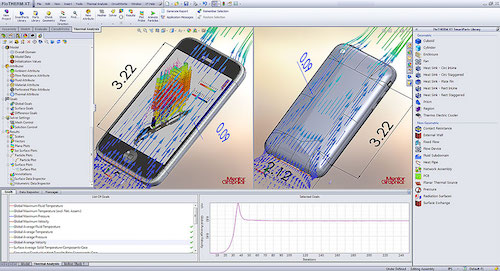
FloTHERM XT can be tapped during all stages of the electronics design process, from conceptual design through manufacturing. Image Courtesy of Mentor Graphics
Latest News
December 6, 2016
First it was PLM, then a healthy dose of simulation software, and now electronic design software. With its recent acquisition of Mentor Graphics, Siemens is broadening its software portfolio in an effort to conquer what it sees as the next big frontier: the industrial digital enterprise.
Last month, the industrial giant announced plans to acquire the maker of electronic design automation tools for $37.25 a share, which amounts to an enterprise value of roughly $4.5 billion. Hardly chump change. While Mentor and the category of EDA (electronic design automation) software have been around for decades, Siemens saw an opportunity to pounce now, to expand its industrial software and automation business and to advance its Vision 2020 strategy for industry 4.0 or the industrial Internet as manufacturers race to digitize old-line factories.
 FloTHERM XT can be tapped during all stages of the electronics design process, from conceptual design through manufacturing. Image Courtesy of Mentor Graphics
FloTHERM XT can be tapped during all stages of the electronics design process, from conceptual design through manufacturing. Image Courtesy of Mentor Graphics“Mentor Graphics complements Siemens Digital Factory in terms of industries, product design domains and production phases,” says Eric Sterling, senior vice president, Siemens PLM Software. “Fully integrating EDA in Siemens Digital Factory solutions gives us a first mover advantage over other PLM players and creates an integrated solution and comprehensive platform for customers and Industry 4.0.”
In addition, convergence of mechanical, electrical and software requires a similar integration between product design and manufacturing, and hence is a natural part of the firm’s multi-year product roadmap for Digital Factory. The acquisition will allow Siemens to be first to offer mechanical, thermal, electrical, electronic and embedded software design capabilities on a single, integrated platform, and will aid customers developing increasingly complex and connected products, including autonomous vehicles.
 The Tanner AMS IC design flow supports analog/mixed-signal design in one highly-integrated, end-to-end flow. Image Courtesy of Mentor Graphics
The Tanner AMS IC design flow supports analog/mixed-signal design in one highly-integrated, end-to-end flow. Image Courtesy of Mentor GraphicsThe Mentor Graphics products, including the FloTherm thermal analysis tools, will also advance Siemens’ effort to simulate real-world characteristics of products, including the ability to create complete digital twins of products and manufacturing and maintenance processes. In addition to its own simulation capabilities, Siemens acquired CD-adapco last year, including its Star-CCM+ simulation software and Red Cedar HEEDS optimization software.
It also released Simcenter in June, a new CAE portfolio of products positioned as a cornerstone for predictive engineering and creating digital twins to more accurately predict product performance throughout an entire lifecycle.
“Innovation in products is increasingly leveraging the combination of electronics, software and mechanical content,” Sterling says. “Companies today have to understand the impact of changes across all three domains in order to make the trade-offs necessary to lower cost, increase quality and effectively maintain their products.”
Watch this short video to explore some of the automotive electronics cooling solutions available from Mentor Graphics.
Subscribe to our FREE magazine, FREE email newsletters or both!
Latest News
About the Author
Beth Stackpole is a contributing editor to Digital Engineering. Send e-mail about this article to [email protected].
Follow DE





